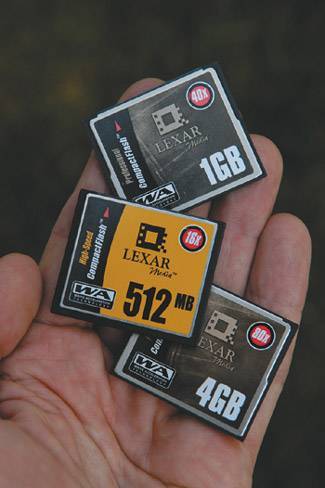Becoming Computer Literate
| Digital photography requires significant computing power. While you might not need the most expensive computer, you're going to want a nice machine on which to view, sort, and share your images. (See Chapter 7 for more on photo sharing.) You might not always travel with your computer (thought most pro photographers do), but when you get back home you're going to want a lot of computing muscle to work on those copious files you've generated. Avoid the bargain-priced entry-level systems offered by many companies. Instead look for a computer that's advertised as being at least in the middle of a company's lineup. While computer specifications change almost monthly, a consumer-level photographer will probably end up spending just over $1,000 on a system, while a prosumer might spend a bit over $2,000, and a pro from $3,000 to $8,000. TIP Sure there are printers on the market with slots for your digital storage cards, allowing you to print without using a computer, but that's really just a novelty. A computer gives you a place to edit your images, store them, back them up, share them, and print them. It might feel cumbersome to bring a computer on the roadeven a laptopbut it's the best way to check your images to make sure that you got the shots you want (Figure 1.21). Plus, with free wireless Internet connections all over the world, you can send people photos of your trip to Europe while you are still on your trip. Figure 1.21. Taking a laptop computer along means one more thing to pack and carry, but it is worth the trouble for digital photographers. You'll be able to download your images, make sure you're getting the photos you want, and back up the photos before returning home. (Photo by Reed Hoffmann)
If you're going on a trip where you can't take your computer, you can use a portable storage device to transfer your images while you're on the road (Figure 1.22). You can even use some of them to burn a CD. The problem is that they're usually almost as heavy as a laptop computer, and they don't provide any way to edit or manage your images while you're away from the office. (See Chapter 6 for more information on in-field naming, and why it's a good idea to bring a computer.) Figure 1.22. The other option for downloading images while on a trip is to use a digital wallet device, like the Flashtrax by SmartDisk. (Photo by Michael Schwarz)
Companies like Nixvue, Delkin, Epson, and others make portable devices that act as both card readers and data storage devices. Computers advance at a rapid rate. A great rule of thumb is to look for computers that are advertised for hard-core computer gamers, or video editors. Both these user groups require a lot of horsepower to get the job done. Some key things to look for when shopping are:
If you're traveling with a laptop, you'll want to gear up on accessories, too. Make sure you've got the following before you go:
Moving Your Photos from Camera to ComputerYou'll also need some way to get your images from your camera into your computer. The best way to do this is with a FireWire or USB 2.0 external card reader (Figure 1.23). Moving pictures over with the cable that came with your camera drains the battery in your camera. Using an external card reader ensures the fastest transfers and maintains battery life. Figure 1.23. An external card reader is a must for getting images into the computer quickly and efficiently. (Photo by Reed Hoffmann)
Improving Your MemoryManufacturers ship new digital cameras with anemic memory cards. Before you leave on your trip, buy a few high-capacity cards (Figure 1.24). A five-megapixel camera can shoot a few hundred images with a 1GB storage card, but only three or four images with the 16MB card that comes in the box. Figure 1.24. The rule of thumb is to buy several cards for your camera, and the largest sizes you can afford. (Photo by Reed Hoffmann)
TIP You'll want a few cards so that you can keep shooting even after you've filled up a card with great travel images. You'll also want to make sure you've got enough cards to keep taking pictures if you lose one or it stops working. |
EAN: 2147483647
Pages: 79



